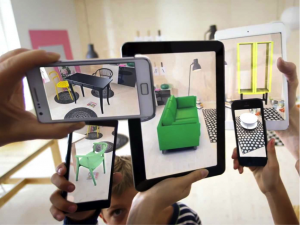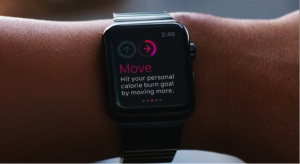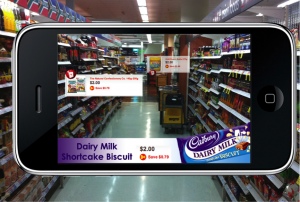By Betty Adamou
As a game developer for market research and data collection, I always have one eye on the evolutions in software and hardware in the games industry, which is a huge advantage, as so much technology is born from that industry to push the boundaries of entertainment, and more (Oculus Rift and Halonens are two such examples). Being on the pulse of what happens in the games industry helps to keep me up to speed of course, but crucially, it indicates and informs how the games I develop for data collection will look like in the future, and how the ResearchGames I make will be interacted with by future ‘playspondents’.
 When we think of mobile today, it is likely we’re thinking of our current mobile devices; android phones, iPhones, tablets and phablets.
When we think of mobile today, it is likely we’re thinking of our current mobile devices; android phones, iPhones, tablets and phablets.
But what is ‘mobile’ is already diversifying massively, and indeed, in as short a time as 2-3 years, mobile (in the context of market research) could mean anything from taking part in a quick survey on our Apple/Another-Brand Smart Watch, accessing Augmented Reality based surveys from our mobile devices, speaking into our hoodies to give opinions through the smart fabric we’re wearing, our movements around a supermarket being tracked through GPS footwear, or using Virtual Reality or Google Glass for brands to collect observational data from the things we do when we are immersed in a virtual environment, or a real one. And this stuff already exists, it’s no longer ‘future tech’. So pretty soon, when someone asks you “What’s next for mobile MR?”, your answer should be “Which mobile?”.
Mobile may also mean tracking journeys and activities; there are organizations (like MESH Experience) who focus much of their attention to collecting data on a users’ interactions with various media touch points, and this is achieved through relying on multiple formats; texts are sent, surveys are being filled out on mobile devices on-the-move and in real-time (when the user has experienced a media touch-point), so in this case, the survey is mobile and so is the participant; in fact, the mobility of the participant is key.
 We already know from Neilsens’ 2013 mobile consumer report that accessing the internet on a mobile device has already outweighed hours spent accessing the internet on PC and laptop (34 hrs on mobile VS 27 hrs on PC/Laptop) so if you don’t have a mobile strategy in place yet, you better start because in the near future, we’ll be seeing a lot more focus on collecting data in real-time from participants on-the-move, while collecting data from what they do, yes, but also how they do it. And more crucially, understand why they do what they do, at exactly the time when they’re doing it. Sounds creepy yes, and this is exactly what Ray Poynter was talking about in his recent NewMR webinar on Innovation – watch out for the creepiness! No one wants a future as depicted in upcoming film ‘The Circle’ as one likes being spied on, even if this type of technology and these abilities are already quite prevalent in our daily lives. However, these technologies, like VR, that can observe different kinds of behaviours, well, they’re exciting. Dare I say, they’re bloody cool (as long as legislation is in place so it doesn’t creep me out).
We already know from Neilsens’ 2013 mobile consumer report that accessing the internet on a mobile device has already outweighed hours spent accessing the internet on PC and laptop (34 hrs on mobile VS 27 hrs on PC/Laptop) so if you don’t have a mobile strategy in place yet, you better start because in the near future, we’ll be seeing a lot more focus on collecting data in real-time from participants on-the-move, while collecting data from what they do, yes, but also how they do it. And more crucially, understand why they do what they do, at exactly the time when they’re doing it. Sounds creepy yes, and this is exactly what Ray Poynter was talking about in his recent NewMR webinar on Innovation – watch out for the creepiness! No one wants a future as depicted in upcoming film ‘The Circle’ as one likes being spied on, even if this type of technology and these abilities are already quite prevalent in our daily lives. However, these technologies, like VR, that can observe different kinds of behaviours, well, they’re exciting. Dare I say, they’re bloody cool (as long as legislation is in place so it doesn’t creep me out).
As market research companies increasingly become software developers and tech power-houses, the hurdles to overcome are to ensure that the new ‘surveys’ (if we can even call them that in the future) are accessible on new mobile devices (good luck making a grid questionnaire accessible on the Apple iWatch) and we must create robust rules and regulations on the way data is collected ethically from participants using other types of emerging tech for MR, such as virtual reality headsets.
As massively excited as I am about Virtual Reality (and am visiting a much-loved games company soon for a little test drive!) I have a hunch that most wide-spread new fever of excitement to grasp MR will still be Augmented Reality. Yes, it’s been around for ages. No, MR hasn’t done much with it yet. But something tells me it’s a-coming.
Organizations like Blippar (who have worked with some Fortune 500 companies such as Coca-Cola, Heinz and PepsiCo to name a few) have used their Augmented Reality app to bring innovative and immersive experiences in marketing that have never been done before. Blippar have been allowing people to use their mobile devices to ‘see’ products through their mobile phone camera, and then give information to the shopper, or collect information from the shopper, based on the product they’re viewing.
There is so, so much scope for market research with Augmented Reality, it’s ridiculous. Because technology such as Augmented Reality has existed for over a decade, some of the obstacles in applying this kind of tech to mobile market research may be cost-based, e.g. the need to purchase software or even hardware licenses, and this may not come cheap. Of course there is the option to make-it-yourself, however this model could be more expensive in the long run and force researchers to play catch-up with technology that already exists, and no one in market research can afford to chase a moving train right now. So rather than duplicate the work, it looks like researchers will be forced to buy into this already existing technology. If it takes off in MR.
But the question is: which emerging mobile tech do you harness for your mobile market research for tomorrow? Virtual Reality? Augmented Reality? GPS tracking? The choice will depend on where your clients’ businesses need to grow.
 But making that choice is hard though.
But making that choice is hard though.
It’s like being a kid in a candy store but with only 5 minutes, and only 50¢; which mobile technology do you choose?
Because the choice you make about which mobile technology you’re going to cater for as a research supplier will equate to some pretty tough choices about the use of your human resources, money and time.
 The choice you make will also either widen your net, or reduce your client base. Go too ‘futuristic’ and you may alienate some clients, but don’t be edgy enough and suddenly you’re not on the roster list of ‘innovative research suppliers’.
The choice you make will also either widen your net, or reduce your client base. Go too ‘futuristic’ and you may alienate some clients, but don’t be edgy enough and suddenly you’re not on the roster list of ‘innovative research suppliers’.
But what about existing survey software providers? Well, for the general use of surveys on a mobile phone device, the challenges to overcome for them is ensuring that their existing survey software has an extended menu of options so that surveys for mobile phones can still have a beautiful look and feel (basic things like using icons and images instead of text all the time). For the future though, will these survey software providers still be around? They too will have to diversify to survive.
My advice is this: if you don’t know what choice to make, don’t do anything at all just yet.
We’re researchers right? So let’s do what we do best. Research. My advice is to do the following four things that will help inform your mobile technology investment for the future:
1) Keep abreast of technology being developed and who is using it. For example, think about what implications it will have on the market research industry, your own business, and your clients’ businesses that Facebook bought the Oculus Rift earlier this year. What consequences may that have in 2016? 2020? What will happen if more tech brands produce watches similar to Apple iWatches, resulting in internet accessible watches become widely adopted? Also, help to educate your team; don’t just be the only one keeping an eye on innovations in tech, encourage your team to do the same.
2) Ask yourself: where do you want to take your business in the future? The spectrum of staying traditional as a market research agency, right through to using smart fabrics, smart accessories and virtual reality each has its implications on your clientele and scope for revenue. In today’s age, a singluar researcher and a singular research company are expected to provide a massively diverse menu of services; from fieldwork to online surveys, to infographics, reporting dashboards, and be a business-decision partner. How you see your business going in the future will help to inform the mobile technology choice you make.
3) Speak to your clients; where are their businesses heading? Who will be their competition tomorrow? What’s in their periphery for their modes of marketing, sales and product development in the next 5 years? This will help to inform you about what they will want, and what they will need, and give you a head start in evolving your research business to help them use market research as a business development tool.
4) Ask the governing bodies of market research about it. Actually, I’ll do it for you as I’m here! ESOMAR, MRIA, MRS…are there any ethics and privacy rules being developed for the use of these mobile technologies? Let us know!
To the researcher reading this: Do these four things, and you can make an informed choice on the best mobile technology that may help you to help your own research business, and your clients’ businesses, in the near future.
Any thoughts or comments on this? Please share!
A condensed version of this article appeared in Research News, June 2015 edition, on 9th June 2015. Click here to read the full feature with views on the future of mobile research from over 15 industry thought leaders.
